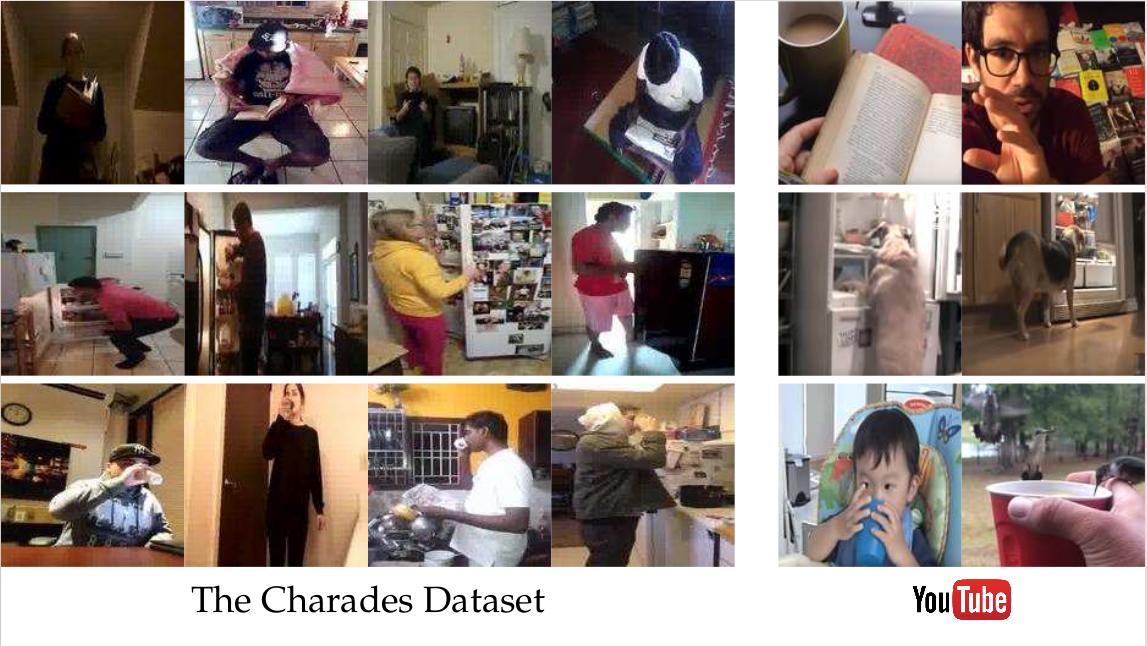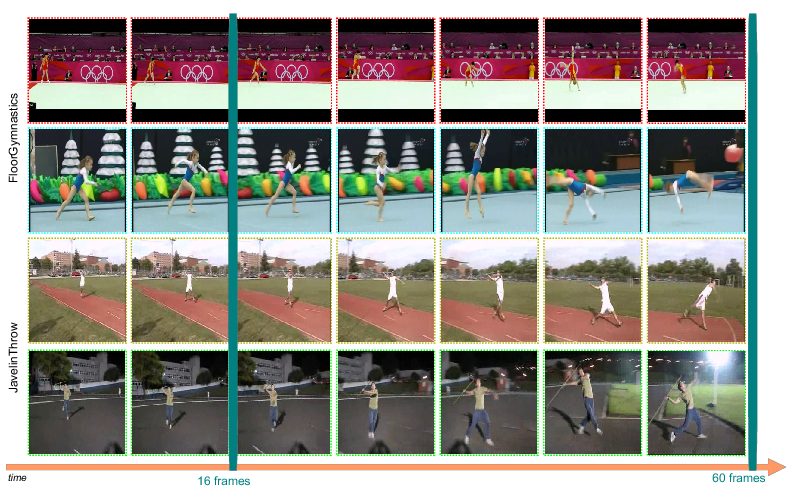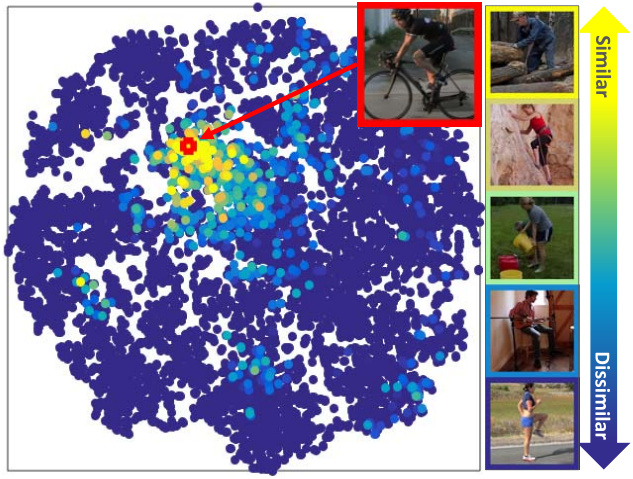Section: New Results
Human activity capture and classification
Hollywood in Homes: Crowdsourcing Data Collection for Activity Understanding
Participants : Gunnar A. Sigurdsson, Gül Varol, Xiaolong Wang, Ali Farhadi, Ivan Laptev, Abhinav Gupta.
Computer vision has a great potential to help our daily lives by searching for lost keys, watering flowers or reminding us to take a pill. To succeed with such tasks, computer vision methods need to be trained from real and diverse examples of our daily dynamic scenes. While most of such scenes are not particularly exciting, they typically do not appear on YouTube, in movies or TV broadcasts. So how do we collect sufficiently many diverse but boring samples representing our lives? We propose a novel Hollywood in Homes approach to collect such data. Instead of shooting videos in the lab, we ensure diversity by distributing and crowdsourcing the whole process of video creation from script writing to video recording and annotation. Following this procedure we collect a new dataset, Charades, with hundreds of people recording videos in their own homes, acting out casual everyday activities (see Figure 9). The dataset is composed of 9,848 annotated videos with an average length of 30 seconds, showing activities of 267 people from three continents. Each video is annotated by multiple free-text descriptions, action labels, action intervals and classes of interacted objects. In total, Charades provides 27,847 video descriptions, 66,500 temporally localized intervals for 157 action classes and 41,104 labels for 46 object classes. Using this rich data, we evaluate and provide baseline results for several tasks including action recognition and automatic description generation. We believe that the realism, diversity, and casual nature of this dataset will present unique challenges and new opportunities for computer vision community. This work has been published at ECCV 2016 [15].
|
Unsupervised learning from narrated instruction videos
Participants : Jean-Baptiste Alayrac, Piotr Bojanowski, Nishant Agrawal, Josef Sivic, Ivan Laptev, Simon Lacoste-Julien.
In [8], we address the problem of automatically learning the main steps to complete a certain task, such as changing a car tire, from a set of narrated instruction videos. The contributions of this paper are three-fold. First, we develop a new unsupervised learning approach that takes advantage of the complementary nature of the input video and the associated narration. The method solves two clustering problems, one in text and one in video, applied one after each other and linked by joint constraints to obtain a single coherent sequence of steps in both modalities. Second, we collect and annotate a new challenging dataset of real-world instruction videos from the Internet. The dataset contains about 800,000 frames for five different tasks that include complex interactions between people and objects, and are captured in a variety of indoor and outdoor settings. Third, we experimentally demonstrate that the proposed method can automatically discover, in an unsupervised manner, the main steps to achieve the task and locate the steps in the input videos. This work has been published at CVPR 2016 [8].
Long-term Temporal Convolutions for Action Recognition
Participants : Gul Varol, Ivan Laptev, Cordelia Schmid.
Typical human actions such as hand-shaking and drinking last several seconds and exhibit characteristic spatio-temporal structure. Recent methods attempt to capture this structure and learn action representations with convolutional neural networks. Such representations, however, are typically learned at the level of single frames or short video clips and fail to model actions at their full temporal scale. In [20], we learn video representations using neural networks with long-term temporal convolutions. We demonstrate that CNN models with increased temporal extents improve the accuracy of action recognition despite reduced spatial resolution. We also study the impact of different low-level representations, such as raw values of video pixels and optical flow vector fields and demonstrate the importance of high-quality optical flow estimation for learning accurate action models. We report state-of-the-art results on two challenging benchmarks for human action recognition UCF101 and HMDB51. This work is under review. The results for the proposed method are illustrated in Figure 10.
|
Thin-Slicing forPose: Learning to Understand Pose without Explicit Pose Estimation
Participants : Suha Kwak, Minsu Cho, Ivan Laptev.
In [12], we address the problem of learning a pose-aware, compact embedding that projects images with similar human poses to be placed close-by in the embedding space (Figure 11). The embedding function is built on a deep convolutional network, and trained with a triplet-based rank constraint on real image data. This architecture allows us to learn a robust representation that captures differences in human poses by effectively factoring out variations in clothing, background, and imaging conditions in the wild. For a variety of pose-related tasks, the proposed pose embedding provides a cost-efficient and natural alternative to explicit pose estimation, circumventing challenges of localizing body joints. We demonstrate the efficacy of the embedding on pose-based image retrieval and action recognition problems. This work has been published at CVPR 2016 [12].
|
Instance-level video segmentation from object tracks
Participants : Guillaume Seguin, Piotr Bojanowski, Rémi Lajugie, Ivan Laptev.
In [14], we address the problem of segmenting multiple object instances in complex videos. Our method does not require manual pixel-level annotation for training, and relies instead on readily-available object detectors or visual object tracking only. Given object bounding boxes at input as shown in Figure 12, we cast video segmentation as a weakly-supervised learning problem. Our proposed objective combines (a) a discriminative clustering term for background segmentation, (b) a spectral clustering one for grouping pixels of same object instances, and (c) linear constraints enabling instance-level segmentation. We propose a convex relaxation of this problem and solve it efficiently using the Frank-Wolfe algorithm. We report results and compare our method to several baselines on a new video dataset for multi-instance person segmentation. This work has been published at CVPR 2016.





